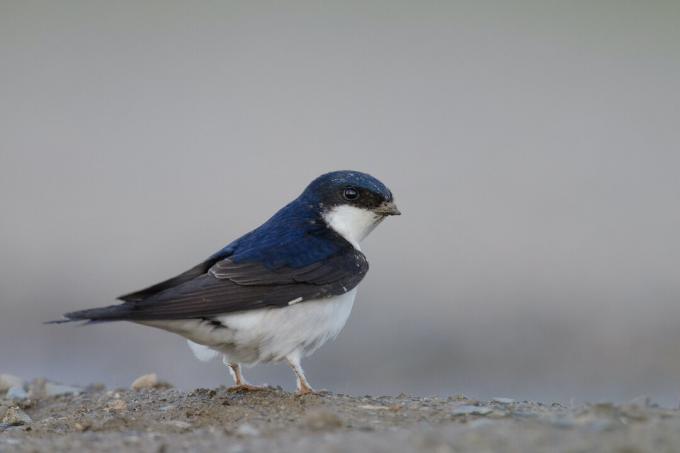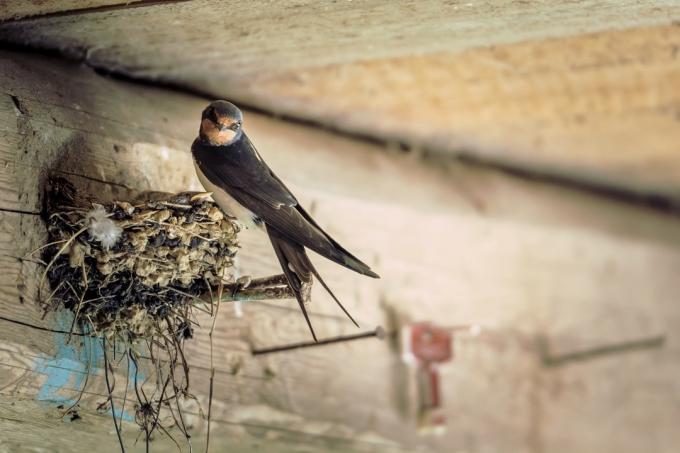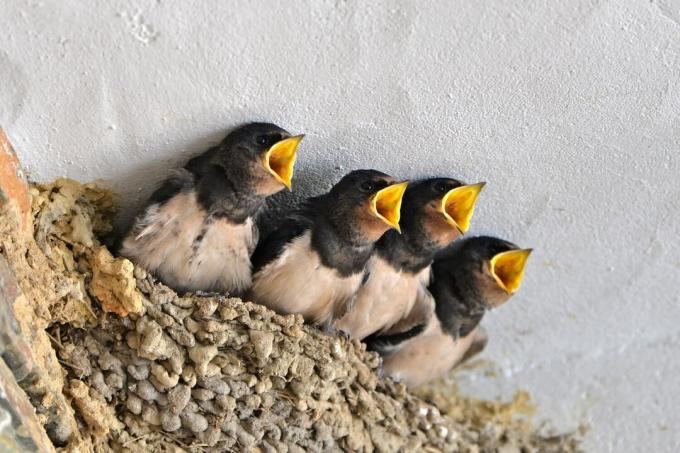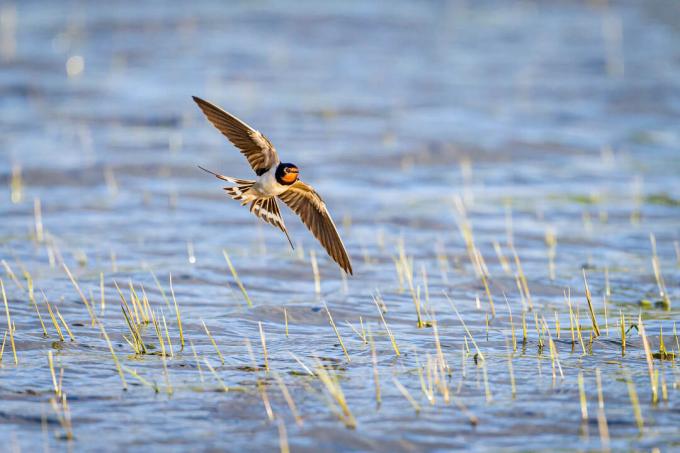What do barn swallows, also called house swallows, look like? How can you tell them apart from house martins? This article will tell you everything you need to know about barn swallows.

The Barn Swallow (Hirundo rustica) is next to the House martin our most common species of swallow. The elegant planes are classic cultural followers that have adapted excellently to man-made living spaces. They prefer to find shelter in cattle sheds and barns in rural areas. There they feed on the flying insects over the fields and use clay puddles on dirt roads to build their nests. However, this idyllic picture has been wavering for several decades: There are fewer and fewer smallholders, dirt roads are being paved and insects are becoming increasingly popular drops drastically. In addition, there are losses from direct hunting in their African wintering areas. Because of these problems, the number of barn swallows is steadily declining and the former "Bird of the Year 1979" is now on the red list and is classified there as endangered. Everything you need to know to identify the native swallows, their breeding biology and possible protective measures can be found in our profile below.
contents
- Barn swallow: fact sheet
-
How do you recognize barn swallows?
- What is the difference between barn swallows and house martins?
- How does the singing of barn swallows sound like?
- What do the young birds of the barn swallow look like?
- Where does the barn swallow build its nest?
- How do you recognize the barn swallow eggs?
- How can you distinguish between male and female barn swallows?
- What is your preferred habitat?
- When do barn swallows breed?
- What does the barn swallow do in winter?
-
How can you support barn swallows?
- What do barn swallows eat?
- Which nesting aids are suitable for the barn swallow?
- How can you give barn swallows additional support?
- How can barn swallows in distress be helped?
Barn swallow: fact sheet
| size | About 17 - 19 cm |
| weight | About 20 g |
| Breeding season | May - August |
| lifespan | Up to 8 years |
| habitat | Farms, settlements, cities |
| Feed preference | insects |
| Threats | Lack of food, nesting material and nesting sites; direct pursuit |
How do you recognize barn swallows?
Anyone who observes a barn swallow in the sky immediately recognizes the tapering wings and the swallow's typical forked tail. In the barn swallows, the latter is particularly characterized by the very long, narrow ends, also known as tail skewers. In flight, the top and throat of the barn swallow appear uniformly dark, while the chest, belly and lower wings are in light contrast. On closer inspection, however, the swallows shine on the top in a metallic blue-black, while the throat is also adorned with metallic, shiny, rust-red feathers.

What is the difference between barn swallows and house martins?
Barn swallows and House martins can often be observed together over fields or bodies of water. The graceful fliers are sometimes so fast that it is difficult to observe the subtle differences between the species. Once you have internalized these, however, the determination is very easy. First of all, the house martins lack the long tail skewers that make the barn swallows appear so elegant. In addition, the former have a consistently light underside - including the throat. And finally, the house martins always have a gleaming white lower back, also called rump, which stands in contrast to their otherwise blue-black back.

How does the singing of barn swallows sound like?
The singing of the barn swallows consists of a lively, unstructured chirping, which often ends in a long, dry purr. In addition, similarly lively calls can almost always be heard in flight: "Witt-witt-witt".
You can find out what the barn swallow's singing sounds like in this sound recording:
What do the young birds of the barn swallow look like?
Young barn swallows are clearly recognizable by their light underside and dark, blue-black top. The throat is also dark in color, which clearly distinguishes it from young house martins. However, they still lack the intense, rust-red throat coloration of the adult animals and the long tail skewers.

Where does the barn swallow build its nest?
Barn swallows prefer classic barns and cattle sheds made of wood for building their nests. But they also use other buildings or protected building facades. The nests are attached to the vertical wall at the top under the roof. A lot of clay and the roughest possible subsurface are required for this construction. In the absence of suitable buildings, barn swallows also breed under bridges and attach their nests there to the girder.

How do you recognize the barn swallow eggs?
The eggs of the barn swallows measure an average of 2 x 1.4 centimeters and are of a white basic color with dark, reddish speckles. The females lay four to six eggs in a bowl-shaped nest made of clay and plant fibers, which is padded with fine feathers.
How can you distinguish between male and female barn swallows?
Male and female barn swallows look very similar at first glance. As is so often the case in the animal kingdom, the males stand out a little more. The female specimens have, on average, shorter tail skewers and a less intensely colored throat. The former are more prominent among the males because they vie for the favor of the females. Long tail skewers express the male's vitality and are intended to impress the female barn swallows.
What is your preferred habitat?
The ideal habitat for barn swallows consists of a rural region with small-scale cattle stalls and barns, abundant insects and clay puddles. But barn swallows also feel at home in urban areas if there are suitable buildings or facades as well as suitable natural areas for searching for nesting material and food.
When do barn swallows breed?
The breeding season of the barn swallows begins in May and can extend into August, as breeding pairs can raise up to three broods per season under suitable conditions. After laying eggs, the female incubates the eggs for at least two weeks. The newly hatched young birds are then supplied with plenty of insects by their parents and need about 18 to 23 days before they can leave the nest.

What does the barn swallow do in winter?
Barn swallows do not overwinter in their breeding areas, but take refuge in more southerly regions. Our native populations spend the cold winter months mainly in Central and South Africa. For the long journey, the barn swallows sometimes form very large swarms in autumn. It is not uncommon for the birds to be seen crowded by the hundreds on trees or power lines during this time.
How can you support barn swallows?
In the last few decades the barn swallow population has declined dramatically due to lack of food and a lack of nesting facilities. If you want to support the local birds in your own garden, you will find important tips here for a swallow-friendly home.
What do barn swallows eat?
Barn swallows are very good hunters. They catch flying insects from the air and can therefore often be observed in droves over fields or water surfaces during spectacular flight maneuvers. Since insects tend to be in short supply here in winter, the swallows cover large distances in winter to follow the food supply in southern regions. Classic winter feeding is therefore useless with this species.

Which nesting aids are suitable for the barn swallow?
Classic closed nest boxes are not suitable for barn swallows. There is, however, the possibility of forming cup-shaped, open artificial nests out of plaster of paris and attaching them in a barn, in a shed or on a protected part of the facade. It is important to distinguish between meal and swallow nests, because most of them are for sale The swallow nesting aids offered are closed hemispheres, except for a small entrance hole, which are only for House martins are suitable.
Whenever possible, however, the barn swallows prefer to make their own nest. But here too you can support the birds in their work. The right nesting material is often a limiting factor, which can lead to unfinished and unstable nests. You can remedy this by offering a small puddle in which the swallows can search for suitable clay building material. If, on the other hand, your soil is sandy and does not stick so nicely, you can also offer extra loamy, moist soil in a small bowl or in a heap in the garden.
How can you give barn swallows additional support?
In addition to suitable nesting opportunities, the food supply is a second major problem for barn swallows. Because the hunters lose their food base due to the ongoing insect death. If you want to do something good for the local swallows, you should avoid using chemical sprays in your own garden or when you buy groceries. In addition, by creating a flower meadow, you can bring additional life back into your home and sustainably promote the supply of insects. With our Plantura beneficial insect magnet you can create a wonderful habitat for a multitude of small garden dwellers and thus strengthen the food chain from the base.
How can barn swallows in distress be helped?
If you find a young bird outside of the nest, there is one thing you should never do: panic. Because there is not always cause for concern. The respective instruction depends on both the health and developmental status of the bird. Fully feathered young birds have probably left the nest on their own and should, if uninjured, simply be left alone. Fledgled fledglings that have most likely fallen out of the nest should be carefully examined for injuries and, if possible, returned to the nest. If you find injured young animals or if you cannot locate the nest, you should contact a suitable help center, such as the Wild Bird Aid, directly.

The same rules of handling naturally also apply to all other bird species. And if you want to find out more about native birds, then take a look at our other species portraits star, blackbird or Blackcap past.



